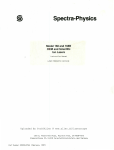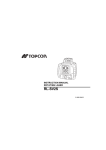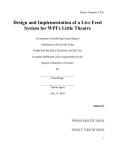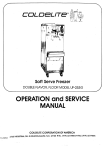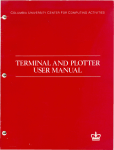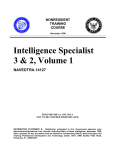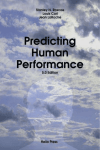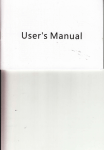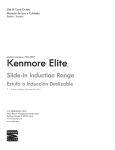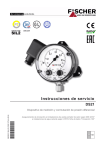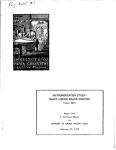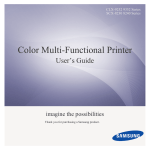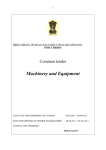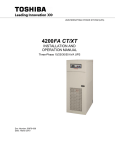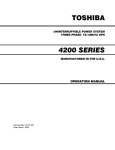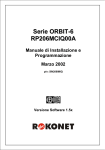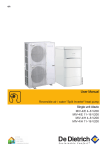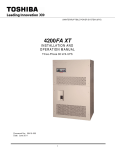Download 92Mar_Krotow - Calhoun: The NPS
Transcript
Calhoun: The NPS Institutional Archive
DSpace Repository
Theses and Dissertations
1. Thesis and Dissertation Collection, all items
1992-03
The impact of cognitive feedback on the
performance of intelligence analysts
Krotow, Geraldine S.
Monterey, California. Naval Postgraduate School
http://hdl.handle.net/10945/30606
Downloaded from NPS Archive: Calhoun
NAVAL POSTGRADUATE SCHOOL
Monterey, California
~.
THESIS
THE IMPACT OF COGNfiITVE FEEDBACK
ON THE PERFORMANCE OF
INTELLIGENCE ANALYSTS
by
Geraldine S. Krotow
March 1992
Thesis Advisor:
KishoreSengupta
Approved for public release; distribution is unlimited
~
f-
-'.
:Thesis
K86767
Unclassified
SECURITY CLASSIFICATION OF THIS PAGE
I
REPORT DOCUMENTATION PAGE
1b. RESTRICTIVE MARKINGS
1a. REPORT SECURITY CLASSIFICATION
Unclassified
3. DISTRIBUTION/AVAILABILITY OF REPORT
2a. SECURITY CLASSIFICATION AUTHORITY
Approved for public release; distribution is unlimited.
2b. DECLASSIFICATIONIDOWNGRADING SCHEDULE
5. MONITORING ORGANIZATION REPORT NUMBER(S)
4. PERFORMING ORGANIZATION REPORT NUMBER(S)
6a. NAME OF PERFORMING ORGANIZATION
Naval Postgraduate School
6b. OFFICE SYMBOL
(If app/kable)
7a. NAME OF MONITORING ORGANIZATION
Naval Postgraduate School
55
1&
6c. ADDRESS (City, State, and ZIP Code)
Monterey. CA 93943-5000
Sa. NAME OF FUNDINGISPONSORING
ORGANIZATION
7b. ADDRESS (City, State, and ZIP Code)
Monterey. CA 93943-5000
9. PROCUREMENT INSTRUMENT IDENTIFICATION NUMBER
Sb. OFFICE SYMBOL
(If applkable)
10. SOURCE OF FUNDING NUMBERS
8c. ADDRESS (City, State, andZIPCode)
Program Element No.
Project No.
Unit Accession
Number
Tas!< No.
Work
11. TITLE (Include Security Classification)
THE IMPACT OF COGNITIVE FEEDBACK ON THE PERFORMANCE OF INTEWGENCE ANALYSTS (UNCLAS)
12. PERSONAL AUTHOR(S) Krotow. Geraldine S.
13a. TYPE OF REPORT
Master's Thesis
I
14. DATE OF REPORT (year, month, day)
13b. TIME COVERED
From
To
115. PAGE COUNT
March 1992
74
16. SUPPLEMENTARY NOTATION
The views expressed in this thesis are those of the author and do not reflect the official policy or position ofthe Department ofDefense or the U.S.
Government.
17. COSATI CODES
18. SUBJECT TERMS (continue on reverse if necessary and identify by block number)
FIELD
GROUP
SUBGROUP
Impact ofcognitive feedback on the performance ofintelligence analysts
19. ABSTRACT (continue on reverse if necessary and identify by block number)
Human judgement and the process ofdeciaion making have been studied in depth for the past century. More recent research has revealed that
feedback is a primary element in the decision making process. Feedback has been categorized according to its role in decision making. Some
categories offeedback include cognitive. feedforward. and outcome. Cognitive feedback may hold the most promise for positively affecting the
decision making process.
Naval Intelligence analysis is a complex process which involves hwnanjudgement and decision making on a daily basis. This thesis sought to
determine that cognitive feedback would enable intelligence analysts to make optimal choices more consistently than if they were presented with
just outcome feedback. Naval Intelligence analysts were the subjects ofan unclassified experiment which captured a realistic task performed
routinely by analysts in the Fleet. The experiment revealed that cognitive feedback produced the most accurate and optimal results. and
indicates that intelligence analysis would benefit from decision support systems that incorporate the element ofcognitive feedback.
•
•
20. DISTRIBUTION/AVAILABILITY OF ABSTRACT
g,.ClASSIFIEDIUNUMITEO
[ ] SAME AS REPORT [ ] OTIC USERS
22a. NAME OF RESPONSIBLE INDIVIDUAL
Kishore Sengupta
DO FORM 1473.84 MAR
21. ABSTRACT SECURITY CLASSIFICATION
Unclassified
22b. TELEPHONE (Include Area code)
/22C. OFFICE SYMBOL
ASlSE
(408)646-3212
83 APR edition may be used until exhausted
SECURITY CLASSIFICATION QF THIS PAGE
All other editions are obBolete
Unclassified
..
i
Approved for public release; distribution is unlimited.
THE IMPACT OF COGNITIVE FEEDBACK
ON THE PERFORMANCE OF
INTELLIGENCE ANALYSTS
by
,
Geraldine S. ~rotow
Lieutenant, Unitta States Navy
B.S., United States Naval Academy, 1986
Submitted in partial fulfillment
of the requirements for the degree of
MASTER OF SCIENCE IN INFORMATION SYSTEMS
from the
NAVAL POSTGRADUATE SCHOOL
March 1992
Author:
Geraldine S. Kroto
Approved by:
•
David R. Whipple, Chairma
Department of
Administrative Sciences
•
11
---_.---
/:t~}b1
t;L
ABSTRACT
•
Human judgement and the process of decision making have been
studied in depth for the past century.
More recent research has
•
revealed that feedback is a primary element in the decision making
process.
Feedback has been categorized according to its role in
decision making.
feedforward,
Some categories of feedback include cognitive,
and outcome.
Cognitive feedback may hold the most
promise for positively affecting the decision making process.
Naval Intelligence analysis is a complex process which involves
human judgement and decision making on a daily basis.
sought
to
determine
intelligence analysts
than if
that
cognitive
feedback
This thesis
would
to make optimal choices more consistently
they were presented with just outcome feedback.
Intelligence
analysts
enable
were
the
subjects
of
an
Naval
unclassified
experiment which captured a realistic task performed routinely by
analysts
in the Fleet.
feedback
produced
the
The experiment revealed that cognitive
most
accurate
and
optimal
resul ts /
and
indicates that intelligence analysis would benefit from decision
support systems that
in~orporate
the element of cognitive feedback.
•
•
iii
~~;:~~:,;.~;!,~.o~r.,.,.,. ;J!3Pu~RY~
;.('\:\~ t;·~r-r:r1""':.""'"
TABLE OF CONTENTS
I.
INTRODUCTION
1
A.
BACKGROUND
1
B.
EXPERIMENTAL TASK .
2
C.
RESEARCH QUESTION .
2
D.
CONTRIBUTION
3
II. THEORETICAL PREMISE
A.
B.
•
•
D.
· .
THE DECISION MAKING PROCESS
4
.
4
. . . ·
1.
Complexity
2.
Decision Making Models
4
5
. ·
a.
Judgement Model
b.
The Brunswick Lens Model
INTELLIGENCE
PROCESS .
C.
. . . .
.
ANALYSIS
AS
5
A
6
DECISION
MAKING
.
11
1.
Decision Making and Intelligence Analysis.
14
2.
Intelligence Analysis as a Process
15
FEEDBACK AND
ITS
ROLE
IN
THE
DECISION
MAKING
PROCESS . .
15
1.
Outcome Feedback
16
2.
Cognitive Feedback
17
HYPOTHESES
18
iv
METHOD
I I I.
A.
B.
C.
D.
E.
G.
IV.
19
· · · . ·
· ··
Experimental Design
· · · · ·
PARTICIPANTS
· ··
TASK . . · ·
·
· · ·
· · ·
1. Selection of Task
· . · ····
2 . Description of Task .
· · · · · · ·
3. Task Variables/Cues
· · ·
PRESENTATION
· · · . ·
· · · ·
1.
Task Description/Information
· · ·
INTRODUCTION
2.
F.
. . · ·
Geographic Representation
SETTING
Geographic Area
2.
System
3.
Data Capture/Entry
·
DESIGN OF FEEDBACK
1.
Outcome Feedback
2.
Cognitive Feedback
DEBRIEF RESULTS
21
•
j
22
22
23
25
25
· · · ·
· · ·
· · · ·
· · · ·
29
29
30
31
31
EXPERIMENTAL RESULTS
B.
20
28
1.
TASK RESULTS
19
27
. · · · · ·
A.
19
. . . . · ·· · · ·
32
37
37
39
.'
•
V.
CONCLUSIONS.
40
A.
SUMMARY . .
40
B.
CONTRIBUTION
40
v
•
C.
FUTURE RESEARCH . . . . . . . . . . . . . . . .
41
APPENDIX
42
LIST OF REFERENCES
61
INITIAL DISTRIBUTION LIST . . . . . . . . . . . . . . .
65
,
•
vi
LIST OF TABLES
•
. . . . . . · · · . . .
Demographics
· · ·
TABLE l .
Lens Model Variables
TABLE 2.
Experiment Subject
TABLE 3.
Experimental Cue Characteristics
25
TABLE 4.
Means and Standard Deviations of Performance
37
TABLE 5.
ANOVA of Model and Error
. . · · · . . .
9
•
21
38
•
•
vii
LIST OF FIGURES
•
Figure 1.
Conceptual Judgement Model
Figure 2 .
Brunswick Lens Model
Figure 3.
Outcome Feedback Displayed as Accuracy
Figure 4.
Analyst's Decision Weights
34
Figure 5.
Consistency Information
35
•
viii
7
. . .
8
.
33
I.
A.
INTRODUCTION
•
BACKGROUND
Research
on decision making
has
reveal ed
the
rol e
of
It
feedback in affecting the decisions of individuals (Hogarth,
1987).
Feedback affects the choice that a decision maker will
make, and can be a crucial el ement in the decision making
process,
as
it
affects both the
decision
maker's
perception
of
task environment
the
environment
and
the
(Hogarth,
1987) .
Feedback can be categorized into several different types,
As described by
including cognitive and outcome feedback.
Jacoby, et aI, 1984,
: .. outcome feedback is information that describes the
accuracy or correctness of the response, cognitive
feedback represents information regarding the how and why
that underlies this accuracy.
A type
of
feedback which has
shown beneficial
cognitive feedback (Balzer et aI, 1989).
may
have
particular
environment,
where
decision maker
decisions.
in
utility
pertinent
a timely
a
Cognitive feedback
complex,
information,
fashion,
is
probabilistic
provided to
can lead
to
the
improved
An exampl e of such an environment is mi I i tary
intelligence analysis.
cognitive
in
resul ts
feedback
on
The
examination of the effects
intelligence
analysts
may
of
lend
validation to current beliefs about cognitive feedback, and
1
t
raise additional questions which, when answered, could provide
a basis for future intelligence decision support systems.
B.
EXPERIMENTAL TASK
To best
capture the effects of
cogni ti ve feedback
on
intell igence anal ysis, a task speci fi call y designed to capture
the analysis process of analysts in the Navy was devised.
The
task was presented to active duty Naval Intelligence analysts
in a format similar to what is used in
th~
Fleet.
The entire
experiment was unclassified, and the geopolitical scenario was
fictitious, yet effort was taken to design a realistic task
environment that the analysts would be familiar with.
C.
RESEARCH QUESTION
Previous studies of military intelligence analysts have
revealed that analysts will tend to seek confirmation of their
decisions (Tolcott et aI, 1989).
If this confirmation can be
provided in the form of cognitive feedback, will the analysts
use the feedback to reach more correct and optimal decisions?
Does
the
form
of
feedback
matter,
or
will
there
be
a
noticeabl e variance between subjects provided wi th and wi thout
cognitive feedback?
Answers to these questions were sought
through the design and implementation of the experiment, and
were the focus of this research.
Analysts were randomly divided into two groups:
feedback and outcome feedback.
cognitive
Each group was presented with
2
the same exact task, but the information presented as feedback
varied, dependent upon which group the analyst was assigned
to.
The results of each group were compared to one another,
and the effects of different types of feedback on the analysts
decisions were collected.
D.
CONTRIBUTION
The
importance
of
the
decision
making
process
to
intelligence analysis is recognized, and the need to determine
which types of feedback are optimal has been previously stated
(Thompson et aI, 1984).
This research attempted to further'
determine if cognitive feedback is relevant and beneficial to
the process of intelligence analysis.
Chapter II provides a literature review of research in the
area
of
intelligence
premise for the study.
experimental method.
resul ts
of
the
experiment,
follow-on
analysis,
the
theoretical
Chapters IV and V discuss statistical
respecti vel y.
may
lays
Chapter III describes in detail the
experiment
studies
and
be
and
concl usions
Resul ts
used
to
of
drawn
from
the
this study and any
develop
more
advanced
decision support system prototypes for the Naval Intelligence
and other military intelligence communities.
3
II. THEORETICAL PREMISE
A.
THE DECISION MAKING PROCESS
1.
Complexity
Human decision making is a complex process.
studies
of this process have revealed that the complexity of decision
making
is
dependent
upon many
individual
factors
such
as
intuition, anticipatory tendencies, and judgemental heuristics
(Hogarth,
1987).
A 1arge
portion
process invol ves human memory
thereof,
of
of
the
decision making
and the capabi 1 i ty,
the human mind to process information
or
1 ack
(Hogarth
1979) .
The human being is a fallible decision maker (Hogarth
1979).
The
human mind
is
unable
to
effectively
process
continuous information from a mul ti tude of sources, especial 1 y
in a stressful environment.
A stressful environment places
the human mind in a position to ignore some information and
process other information, dependent upon existing heuristics
(Hogarth, 1987).
vital,
such
as
In applications where decision making is
diagnostic
medicine
and
tactical
military
scenarios, it is imperative that the information assigned the
least importance is indeed worthy of such a low value.
Each piece of pertinent information contributing to a
decision must be appropriately presented to the decision maker
4
in a manner that will ensure the information is processed with
due
value.
It
is
beneficial
to
fully
understand
the
importance of information presentation in the decision making
process.
This understanding can be accomplished by studying
various decision models as described in subsection II.A.2.
2.
•
Decision Making Models
Researchers
have
attempted
to
capture
the
human
decision making process through observation and mathematical
modeling.
Two models of decision making are the conceptual
judgement
model
described
by
(Hogarth,
Brunswick
1987)
(Libby,
and
the
lens
model,
The
conceptual
1981).
as
judgement model and the lens model appear to approach the task
of decision making from the different aspects of psychology
and mathematics.
Yet the two models are inextricably linked
by the el ement
of
feedback,
a vi tal
making process.
Section II.C identifies and defines feedback
and its varieties in more detail.
part
of the
decision
By examining each of these
models a point of departure for this study was attained.
a.
Judgemen t Hodel
Hogarth's conceptual judgement model divides the
process of decision making into seven basic steps:
(1) task
environment, (2) Schema, (3) Acquisition, (4) Processing, (5)
Output,
(6)
provides
decisions.
Action,
information
and
(7)
that
Outcome.
will
be
Step
(7),
pertinent
to
outcome,
future
This outcome of the decision making process is
5
also
considered
scenarios.
future
a
form
of
feedback
for
future
judgmental
Hence outcome, or feedback, is a means by which
judgements can be
information
to
the
affected.
decision
In becoming
making
pertinent
process,
feedback
establishes its vital role in the decision making process.
The
conceptual
depicted in Figure 1.
model
of
human
judgement
is
Feedback plays a crucial role in the
judgement process, as it provides criteria to both the task
environment and
interpreted by
the
judgement schema.
Brunswick continues
The lens
model
the description
of
as
the
element of feedback in mathematical detail.
b.
The Brunswick Lens Hodel
The Brunswick Lens Model allows the environment to
be observed through a "lens of imperfect cues" (Libby, 1981),
and assigns weights to each of the cues in a specific decision
making
scenario.
situations
in
The
Lens
which
the
Model
is
decision
readily
making
adapted
occurs
to
in
a
probabilistic environment, and the accuracy of a decision is
contingent
both
on
the
individual
decision maker
and
the
environment in which the decision is made (Hogarth, 1987).
The
represents
assigned
the
to
lens
model,
differences
pieces
of
as
depicted
between
pertinent
actual
in
Figure
value
information
2,
weights
by
the
environment, and the value weights assigned to the pertinent
6
1 Task environment
•
Feedb
- - - - ----~ Outcome
Figure 1.
Conceptual Judgement Model (Hogarth, 1987)
7
pieces of information by the decision maker.
information which are
considered pertinent
These pieces of
to a
specific
decision, or task, are formally referred to as cues.
•
•
decision meker
MATCHING
INDEX
Figure 2.
Brunswick Lens Model
1966; Libby 1981).
(c. f. Dudycha and Naylor
The lens model uses identical polynomial equations
for each side of the model;
..
maker.
The
differences
the environment and the decision
lie
weights, for each of the cues.
•
in
the
assigned
or
All of the variables used by
the lens model are listed and defined in Table 1.
8
values,
TABLE 1.
LENS MODEL VARIABLES (c.f. Libby, 1981)
Symbol
Name
Definition
Re
Environmental
Predictability
Rtete '
RR
Predictability
R'Clh'
G
Matching Index
rY..'YR'
r2
Achievement
r,..h
First,
the
lens model
status of the environment.
attempts to
•
·•
capture
the
The environment is represented by
equation 1.
(1 )
Ye,
the
actual
model
imposed
compi 1 ati on of the weights
(xl"
.x n) by the environment.
by
the
(b l .... b n)
environment,
assigned to the
is
a
cues
Likewise, the decision maker's
view of the task is captured in an identical
equation, Ys '
wi th the weights (b l •... b n) assigned to the cues (xl'" x n) by
the decision maker.
Both the environment and the decision maker are
using the same set of cues,
then assigned.
(xl'" x n),
In the most ideal
to which weights are
situation,
the decision
maker employs consistent weights for specific cues, dependent
upon the nature of the task.
9
•
other
factors
that
affect
the
decision-making
process and are thus represented in the lens model
,
•
include
consistency and environmental noise.
Environmental noise is
al so
(Libby,
referred
to
as
predi ctabi 1i ty
Both
1981).
consistency and predictability utilize similar variables in
their calculations.
Rs '
decision
maker
consistency,
is
in
measures
predicting
the
how
consistent
environment.
It
the
is
calculated by a multiple correlation between the cues and the
decision maker's judgements.
Re, predictability, measures how predictable the
environment
is.
If
noise
or
predictability
is
low,
the
probability of the decision maker attaining a reasonable task
accuracy
is
low
(Libby,
1981).
Predictability
can
be
calculated by employing a multiple correlation of the cues and
the actual environmental values.
The accuracy of decisions can be measured through
the lens model, in the form of decision achievement, r a •
Ia=GReRs
(2 )
..
Consistency, Rs ' and predictability, R e, can be calculated to
determine the overall accuracy of the decisions made by the
decision maker.
Decision achievement is an indication of how
10
well an individual, Ys ' matches the environment, Ye , through
this "lens of imperfect cues" (Libby, 1981).
The Brunswik Lens Model lends well to the process
t-
executed by Naval Intelligence and Cryptological analysts.
By
examining the analyst's decision and mathematically comparing
it
to
the
environment's
actual
outcome,
an
index
of
achievement for intelligence analysts can be arrived at for a
specific type of
analysis
task.
The effects
of
various
factors, such as feedback, on the decision making process, can
be examined by comparative analysis of achievement indices for
multiple instances of a generic task.
B.
INTELLIGENCE ANALYSIS AS A DECISION MAKING PROCESS
While intelligence analysis can be a
making
analysis
process
has
involving
not
been
human
complex decision
judgement,
"intensively
intelligence
investigated
by
psychologists for more than thirty years" in the manner human
judgement and decision making have been (Tolcott et al 1989).
A prel iminary 1i terature
review reveals somewhat sporadic
research in
the
area
intell igence
majority
the
material
of
of
focused
on
anal ysis,
wi th
developing
the
decision
support aids for the intelligence analyst .
•
In
1974
Patten
attempted
to
initiate
a
method
of
organizing data and information received by an intelligence
system to help analysts.
Patten's concern was the following:
11
..
[that] intelligence analyst[s] working on specific
problems must be able to selectively obtain information
relevant to a specific problem without becoming bogged
down in irrelevant information." (Patten, 1974)
Patten's study focused on the information and data relevant to
the analysis process, but not the analysis process itself .
•
sticha,
Patterson,
and
Weiss
researched ,and
determined
Approximate Reasoning Methods for Decision Aids in 1982, which
I ed to the development of· a prototype decision aid for Ai r
Force target nomination.
The reason for studying approximate
reasoning methods was to hopefully" ... achieve a system that
could facilitate an intelligence analyst's efforts" (sticha et
aI, 1982).
Hence, the actual intelligence analysis process
became the focus of the research.
An Intelligence Aid for Estimating Enemy Courses of Action
(AI!ENCOA) was developed in 1985 in an attempt to provide
cognitive
support
to
intelligence
analysts
decision rule bases (Lehner et al 1985).
was developed as
by
altering
AI/ENCOA software
a prototype decision aid to assist Army
tactical intell igence anal ysts assigned wi th choosing feasibl e
enemy courses of
action.
This prototype uti I ized Mul ti-
Attribute utility (MAU) models
and enabled the analyst
to
assign weights to each alternative.
Another decision support software package created for Army
...
intell igence anal ysts was DINAA:
The Dynamic
Assessment Aid, by Probus and Donnell, in 1986.
Intell igence
DINAA allowed
the analyst to determine probabi 1 i ties for each avenue of
12
approach as determined by AI/ENCOA.
DINAA utilized Bayes'
theorem to adjust and assess probabilities.
The Prototype
Analyst Workstation (PAWS) developed in 1990 was similar to
AI/ENCOA in that it allowed the analyst to define alternative
courses of action open to the enemy, with the aid of MAU (D.
•
Thompson et al, 1990).
Cohen, Laskey, and Tolcott developed a prototype decision
aid
in
1987
that
could
be
personalized
for
each
user.
Submarine commanders were used as the subjects, and the idea
that
individual decision makers differ both among
themselves and from task to task in the
decision strategy they prefer
(Cohen et al,
1987)
was examined.
aid
allowed
This "personalized and prescriptive" decision
the
submarine
commander
to
examine
di fferent
decision methods, weights, and trade-offs for each decision.
Tolcott, Marvin and Lehner conducted research in 1989 in
" ... an
at tempt
to
further
the
investigation
behavi or under! ying intell igence analysis"
1989).
tend
to
of
cogni ti ve
(Tol cot t
et al /
This study revealed that an intelligence analyst will
"[remain}
with
[his/her]
original
estimate"
of
a
scenario, regardless of update information presented (Tolcott
et al,
1989).
analysts will
It
appears as
though mi I i tary intell igence
" ... pay more attention to supportive than to
contradictory evidence /"
decision/estimate
as it
(Tolcott
et
13
pertains
al,
to
1989).
their
original
This
research
...
elicited another research question:
if update information
could be defined as feedback, and if feedback could be further
delineated
into
different
types
of
feedback,
analyst's perception of update information,
•
affected by the specific type of
would
an
or feedback,
be
feedback provided?
This
question is addressed in section II.C, Feedback and. its Role
in the Decision Making Process.
1.
Decision Making and Intelligence Analysis
The process of intelligence analysis is comparable to
the standard decision making process but even more pronounced
due to the high levels of stress, dynamic environments, and
the
crucial
evaluating
1984),
the
nature
of
the
large amounts
analyst
must
decisions
of
arrived
incoming data
"provide
commanders' deci si ons are made,"
at.
After
(Adelman et
information
on
aI,
which
val ida ting the anal ys ts '
position as a critical one in the chain of intelligence and
operational events (Lewis and Copeland, 1982).
It is clearly
recognized that the analyst routinely faces an intricate and
complex task that may be gargantuan in its proportions (Luckie
et
al
1968).
Essentially,
the
analyst
is
tasked
with
repeatedly "quantifying assessed probabilities" (Probus and
Donnell, 1986).
<II
Very often, the analyst is relying solely on
intuitive feelings, with little or no substantiated feedback
on his/her decision making process.
14
2.
Intelligence Analysis as a Process
Naval
making
Intelligence
process.
analysis
Intelligence
utilizes
analysis
can
studied with the lens model and conceptual
the
decision
therefore
be
judgement model,
and may yield improved performance results with the provision
of feedback to the analyst.
Effective intelligence analysis
can be defined as an internal, concept-driven process vice an
external, data-driven process (Katter et aI, 1979), and thus,
as an internal process, has the needs of conceptual judgement,
including feedback (Hogarth, 1987).
The intelligence analyst is continually faced with making
probabi 1i ty assessments concerning both categorical events
and events which lie along a continuum (Barclay and
Randall, 1975).
Therefore the decisi on making
could
be
ideally
studied
process used by the
with
the
aid
of
anal yst
Brunswik's
interpretation of the lens model.
C.
FEEDBACK AND ITS ROLE IN THE DECISION MAKING PROCESS
Technically,
feedback
is
the process by which an
environment returns to individuals a portion of the
information in their response output necessary to compare
their process strategy with a representation of an ideal
strategy (Balzer et aI, 1989)
Feedback, as pictured simplistically by Hogarth in his
conceptual
judgement
making process.
model,
is
essential
to
the
decision
Feedback is relevant to the decision making
process and it is widely accepted that
Bet ter performing individuals woul d be more I ikel y to
access and use feedback information (Jacoby et aI, 1984)
15
It is fair to conclude from this that feedback could play an
important role in improving intelligence analysis.
...
There are
many varieties of feedback, such as
outcome and cognitive.
What
suit
types
of
feedback
intelligence analysis?
most
basic
types
of
will
best
the
process
of
The answer becomes clear when the two
feedback,
outcome
and
cogni ti ve,
are
examined.
1.
Outcome Feedback
Outcome feedback is the most basic type of feedback,
and can be described as the results of a decision process that
has al ready
occurred.
The
resul ts
are the
outcome( s)
of
decisions previously made; hence outcome feedback of a current
decision does not facilitate changing or altering the current
decision.
Outcome feedback provides information on previous
decisions only;
feedback
from
current decisions are unaffected by outcome
their
results.
Outcome
feedback
has
been
challenged for its validity as a type of feedback, as it can
only enhance future decisions vice the current decision making
process
(Balzer
demonstrate
et
that
al
outcome
1989).
feedback
Several
may
research
have
utility in an uncertain learning environment
1989) .
Hence,
little
no
in the
as intelligence analysis
frequently occurs in an uncertain environment.
16
to
(Balzer et al
outcome feedback may not be optimal
intelligence analysis environment,
studies
2.
Cognitive Feedback
Cognitive feedback provides the decision maker with
information
about
the
decision
Cogni ti ve feedback allows
currently
being
made.
the decision maker to know
what
their consistency rating is, what weights they have assigned
to cues, and what weights the environment has assigned to the
cues.
Cogni ti ve feedback consists of three el ements;
Task
Information (TI), Cognitive Information (CI), and Functional
Validity Information
(FVI)
(Balzer et al
1989).
Cognitive
Feedback provides what outcome feedback cannot:
on the decision making process as it occurs.
feedback
is
information
that
correctness of the response,
describes
information
"Whereas outcome
the
accuracy
cogni ti ve feedback
information regarding the how
or
represents
and why that underl ies
this
accuracy" (Jacoby et aI, 1984).
Naval Intelligence analysis occurs in a very dynamic
environment.
Since
it
has
been
suggested
that
outcome
feedback is dysfunctional in a dynamic environment (Jacoby et
al 1984), and that the type of feedback believed to be most
beneficial,
most often,
is
indeed cognitive (Balzer et
al
1989), perhaps the feedback with the highest utility for Naval
intell igence and cryptological
anal ysts could be cogni ti ve
feedback.
appears
Cogni ti ve feedback
to hold promise
improving the quality of intelligence analysis.
for
This could be
of the utmost importance since many decisions made by analysts
can affect the safety and lives of others.
17
D.
HYPOTHESES
Because of the importance of decision making
in intell igence anal ysis, it is imperative
that more research be devoted to the types of
decisions that analysts have to make ... what
are optimum feedback mechanisms? (Thompson et
al,1984)
to
This research examined the following hypotheses in an effort
to answer the previous question:
Cogni ti ve feedback is more effective than outcome feedback
in intelligence analysis tasks.
Intelligence analysts provided with cognitive feedback
during their decision making process wi 11 exhibit improved
performance and will make optimal vice satisficing
decisions.
The
research question was
using
Brunswik's
examined through
interpretation
of
the
an
experiment,
lens
model
and
mathematical analysis.
It was imperative to first determine whether or not the
subjects
were
affected
Further· anal ysis
affected:
by
determined exactl y
feedback
how the
in
any
way.
anal ysts
were
positively, in that they were making more accurate
and consistent decisions;
making
cognitive
decisions
which
or negatively, in that they were
were
increasingly
inconsistent with previous decisions.
inaccurate
and
The effect of cognitive
feedback on Naval Intelligence and Cryptological analysts was
the focus of this study.
18
III.
A.
METHOD
INTRODUCTION
*
Naval Intelligence analysts make complex decisions on a
dai I y
basis,
whether
their
anal ysis
is
as
an
individual
analyst for an operational command such as a squadron or ship,
or
they
are
colI ecti vel y
(DOD).
part
of
anal yzes
a
large
data
for
watchstanding
the
Department
team
of
that
Defense
Naval Intell igence anal ys is routinel y invol ves compI ex
decision making and provides a viable arena for examining the
ef f ects
of
cogni ti ve
feedback
on
compl ex
decisi on
making
processes.
The research question was investigated in an experimental
setting
designed
to
most
closely
decisions made by analysts
represent
in the Fleet.
the
type
of
A realistic and
fairlY complex task of moderate to difficult complexity was
created in an
effort
to
employ the broadest
range of
the
analyst's decision making capabilities.
B.
Experimental Design
An experiment involving comparison of results between two
sets
of
subjects
was
devised.
One
set
subjects) was given outcome feedback only;
19
of
subjects
(12
another set (12
sub j ects)
was
gi ven cogni ti ve
and outcome
feedback.
The
presentation of feedback was designed to provide an optimal
amount of information to the subject with minimal complexity
in the presentation format.
The subjects for each part of the experiment were randomly
assigned to receive outcome or outcome and cognitive feedback.
Subjects receiving cognitive feedback had a longer instruction
set to read and understand before they were able to begin the
experiment.
Outcome
feedback
was
presented
as
accuracy,
whereas cognitive feedback was presented as Decision Support
Information.
Both
types
of
feedback,
and
how
they
were
designed and presented to the subject, are described in the
following sections.
C.
PARTICIPANTS
Subjects chosen for this experiment were all on active
duty in the United States Navy.
They are currently serving,
or
requiring
have
served,
in
positions
intelligence
or
cryptologic analysis. Both Enlisted Personnel and Commissioned
Officers were
received
training
experience
positions
varied,
used
at
and
from
in the
by
making
billets
experiment.
U.S.
Navy
intelligence
held
operational
by
All
schools,
and
decisions.
the
have
The
experiment's
intelligence
billets
standard administrative-type billets ashore.
20
subjects
have
had
actual
subjects
afloat,
to
TABLE 2.
EXPERIMENT SUBJECT DEMOGRAPHICS
Demographic
Mean
Standard Deviation
Age (years)
29.0
7.0
Rank (E-l through
0-9)
9.0 (E-9)
3.7
Analysis Experience
(years)
5.5
4.6
How long since
conducted analysis
in the Fleet
(years)
1.5
0.9
The
subject
demographics
were
calculated
with
the
assistance of Minitab (Schaefer and Anderson, 1989).
D.
TASK
The task of "quantifying assessed probabilities" (Probus
and Donnell, 1986) to various cues or pieces of information is
central to the intelligence analyst's decision making process.
Thi s i s academi call y
difficult task,
the
development
anal ysis,
such
and professi onall y acknowl edged as
a
and has been examined and incorporated into
of
di fferent
as The
systems
to
aid
intell igence
Dynamic Intell igence Assessment
Aid
(DINAA) designed by Probus and Donnell in 1986; and described
in the User's Manual
(PAWS)
by Thompson,
for the Prototype Anal yst Workstation
et al,
in
1990.
Both DINAA and
PAWS
represent attempts to first capture, and then aid, the process
of intelligence analysis.
This highlights the first challenge
faced when attempting to prove the hypothesis of this study:
the experiment must include a task similar in complexity to
21
the task performed by a Naval Intelligence analyst on a daily
basis.
,
The validity of the experiment hinged upon the data
collected from the analysts, and the data could only be as
realistic and meaningful as the task itself.
..
1.
Selection of Task
The task of intelligence analysis requires the analyst
to
provide
available.
of
the
a
decision
based
upon
whatever
is
To represent this task and ensure the robustness
experiment,
a
task
similar
anal ysts in the Fl eet was devised.
analyst,
information
or subject,
to
that
performed
The task requires
by
the
to provide his/her best estimate of a
suspect ship's position, based upon given information.
The
given
the
information
was
dependent
upon
whether
subject had access to solely outcome feedback,
or
not
or cognitive
and outcome feedback.
2.
Description of Task
The actual task presented to the analysts involved an
anti-drug smuggling situation.
Anti-drug smuggling tasking
was chosen due to its relevancy in military operations and
intelligence.
The task was first
presented to the analyst
from a political standpoint of the situation in the Background
Information.
The
Background
Information provided
current
domestic and international political and social information as
it pertained to the influx of illegal drugs into the United
states.
The purpose of the Background Information was
22
to
create a basis of familiarity for the analyst, and to give the
task a realistic perspective.
The task was reduced to a singl e si tuation, simi 1ar to
the analysts daily tasks in the Fleet, in the Situation Report
and Scenario, both which narrowed the scope of the illegal
drug
trafficking
trade
to a single
suspect
vessel.
The
anal yst was asked to provide his/her best estimate of the
location of the suspect
vessel
based upon the
information
provided.
Basic
included
information
that
it
Colombia to the
had
provided
on
completed three
the
suspect
previous
vessel
runs
from
u.s. over the past six weeks, tracking east of
Cuba the first time, and west of Cuba the last two times.
The
analyst was told the vessel was estimated to carry up to three
tons of cocaine, and that it was preparing to depart Colombia
once again for the
u.s. mainland.
This basic information on
the suspect vessel provided the analyst with a brief history
of
the
vessel,
scenario,
and
the
an
general
idea
of
geographic
the
location
vessel's
drug
of
the
carrying
capability.
3.
Task Variables/Cues
A real isti c task necessi ta tes variabl es and random
weighting
variables:
of
the
variabl es.
This
task incorporated four
weather, ship type/speed, presence of the Cuban
Navy, and the last contact information on the suspect vessel.
23
All four variables were present throughout the task; thus the
analyst had information regarding each of the four variables
each time he/she was asked to perform the task of providing an
estimated suspect vessel position.
•
Each variable appeared to
be weighted differently in each scenario presented to the
analyst,
and the
combination of
variables varied as well.
the differently
weighted
This was to provide as realistic a
task as possible, and to optimally test the analysts decision
making capabili ties.
However,
ship,
by
as
calculated
the
the actual posi tion of
system,
weighted
the
the
ship
type/speed, weather, and last contact variables equally and
inc 1uded a random error.
variable
was
The proximi ty of the Cuban Navy
negligible in the
actual position.
calculation of
the ship's
The values used for each of the variables as
presented to the analysts are represented in Table 3.
24
TABLE 3.
EXPERIMENTAL CUE CHARACTERISTICS
Variable
Values
Last
Contact
1-12 hours
Ship
Type/Speed
Sailboat
Yawl
Cargo Ship
Speedboat
Sea State
1
2
3
4
(6-8 knots)
(10-12 knots)
(19-20 knots)
(40+ knots)
\
•
= Calm, winds up to 10 knots
= Breezy, winds up to 20 knots
= Heavy swells, winds up. to 45
knots
= Hurricane force, gale winds
up to 80 knots
Cuban Navy
in Area
E.
20 nautical mile radius
15 nautical mile radius
10 nautical mile radius
3 nautical mile radius
PRESENTATION
1.
Task Description/Information
All
provided
to
enhance
the
Information
sub jects,
them,
regardl ess
recei ved
naturalness
and
of
Situation
the
the
of
same
the
type
basic
feedback
information
experiment.
Report
of
provided
to
Background
geopolitical
information on the areas of concern for DOD and the United
states Government.
In this experiment, Background Information
•
1
stated that the focus of
efforts of the U.s.
the President is on the anti-drug
This set the stage for the scenario in
which the subject was asked to provide a position for
25
the
suspect vessel.
Scenario provided information as to what
billet the subject was to place him/herself in, and for what
purpose they were to provide an estimated posi tion of the
suspect vessel.
Pn
r
keeping
with
the
experimental
rule
of
"ten
scenari os per cue" (Bal zer and Doherty, 1991), the anal ys twas
asked to provide an estimated position of the suspect vessel
forty separate times during the experiment.
Each scenario was
independent of any other, and incorporated the four variables,
or cues, provided to the subject.
last
contact,
ship
type/speed,
The four variabl es were
weather,
and
cuban
exercise proximity to the location of the suspect vessel.
actual
values
of
each variable
(hours,
knots,
Naval
The
sea state,
proximity of Cuban Navy in nautic.al miles) were varied in each
scenario.
Thus each scenario used the same four variables,
but in a different combination of values for each instance.
Variables were presented to the analysts in the form
of
message sets,
personnel.
which are very
fami I iar
to
intell igence
An example of a message set is in the Appendix.
Since the entire experimental scenario and background
information was unclassified, so were the message sets, the
origin of each message, and its destination.
The four variables;
weather, and Cuban Naval
last contact, ship type/speed,
activity proximity to the suspect
vessel, were all presented in the message set.
The analyst
was presented with forty message sets in total, each formatted
26
identical to the sample message set in the Appendix, but with
the values of the cues, or variables, randomly varied.
2.
Geographic Representation
The task was designed to best represent the
performed by analysts on a daily basis in the Fleet.
tasks
The task
asked the analyst for his/her best estimate of the suspect
vessel's position, based upon the information presented in the
respecti ve message set.
In a rea 1 si t ua ti on,
the anal yst
would be asked to provide an estimated position in degrees
1a ti tude and 1ongi tude.
To provide a more straightforward
representation of the task and also to place necessary limits
on the pertinent geographic area of the task, a grid square
was designed to cover the geographic area of the experiment.
The analyst was asked to locate the suspect vessel in
an area in the Caribbean, north of Colombia and Venezuela.
The geographic area of the task is depicted in the Appendix.
The grid square was bounded by the following four coordinates:
12N 72W;
18N 72W;
12N 78W;
18N 78W.
The grid square was
divided into thirty-six smaller squares, and each square was
approximately sixty by sixty nautical miles.
assigned a two-digit, unique number.
ease
in
providing
a
position,
Each square was
This allowed for greater
and
thus
greater
ease
in
calculations involving the positions of the suspect vessel.
The grid square did not, however, detract from the continuous
nature
of
the
latitudinal
and
27
longitudinal
scales
of
measurement.
Continuous values
for the position(s) of
suspect vessel were preserved with the grid square as
the
each
position remained unique and numerically higher or lower than
any other grid square.
The grid square numbering maintained
the continuity of the number line.
What was most realistic in the experimental setting
was
that
the message sets
presented mul tiple cues
subjects in a format familiar to the subjects.
to
the
This enhanced
the viability of the results captured by the experiment, as it
allowed
the
analysts
possible to them.
to
complete
a
task
as
familiar
as
Experiment debriefing revealed that nearly
every subject believed the experiment and task to be highly
realistic and believable.
F.
SETTING
Subjects
received
experiment
Background
Information,
Scenario, Si tuation Report, Message Sets, Computer Instruction
Set, and Decision Support Information manually,
leaf binder.
in a loose-
The experimenter presented the subject with the
binder after briefly explaining the geographical area of the
experiment with the aid of a navigational chart.
Background
Information, Scenario, Situation Report, and Message Sets were
described in sections III.D and III.E.
Computer Instruction
Set and Decision Support Information wi 11 be described in this
section, and section III.G, respectively.
28
1.
Geographic Area
A navigational chart identical to those used in the
Fleet by analysts conducting actual tasks was provided, with
the task area delineated in grid format.
Thirty-six squares,
approximately 60 nautical miles X 60 nautical miles each, were
numbered to represent a continuous scale similar to latitude
and
longitude.
numbering
analysis
Each square
system allowed
without
was
for
detracting
unique.
greater
from
The
grid-square
in
statistical
actual
continuous
ease
the
latitude/longitude system employed in the Fleet.
The geographic area of the experiment, defined by the
grid square, was covered with acetate to allow marking of the
area by the ana 1 ys t
wi th a water sol ubI e marker.
Rul ers or
navigational plotters/dividers were provided to the subject
for distance calculation.
Each subject was provided with a piece of scrap paper
and
a
pencil
required.
2.
or
pen
for
any
time-distance
calculations
Calculators were not permitted as a general rule.
System
The experiment was conducted on IBM compatible 286/386
computers,
in private office or computer
laboratory areas.
Each subject was given a one page Computer Instruction Set
which explained the screen on which the vessel's estimated
29
posi tion,
in
entered.
the
form
of
a
grid
square
number,
would
be
Instructions on how to receive outcome or cognitive
feedback were included in the appropriate instruction set.
Additional
subject
on
reminding
computer instructions were presented to the
the
the
screen
of
analyst
the
to
computer
consider
they
each
were
using,
message
set
individually, and to enter each two-digit estimated position
of
the
suspect
vessel
into
analyzed each message set.
the
computer
after
they
had
The last instruction on the screen
directed the subject to "strike any key when ready," upon
which
time
the
four-col umn
screen
for
posi tion
entry
was
displayed on the monitor.
3.
Data Capture/Entry
The system captured the subject's estimated positions
when the subject entered their estimated position for
message set.
each
The subject was presented wi th a monochrome
screen with four columns of ten entry places each.
To the
greatest extent possible, a graphical display was used that
had been found to be effective for approximate comparison of
quantitative information (Brehmer, 1984).
The entry places
for the subject's estimated positions were numbered 1-40, and
further computer instruction information was presented on the
bottom line
•
of
the screen.
The columns
covered the bottom-half of the screen.
for
data
entry
The top-half of the
screen remained blank for subjects receiving outcome feedback
30
only.
When the subjects receiving solely outcome feedback
pressed "END," they were presented with the actual position of
the the suspect vessel (accuracy, or r a,) in the right hand
columns next to their estimated vessel position.
The subjects receiving cognitive feedback were presented
with a menu after they pressed "END."
in the top half of the screen.
outcome feedback
option,
The menu was displayed
After choosing a cognitive or
the subject participating in the
cognitive feedback experiment was provided with decision rule
scales in the top half of the screen, or consistency and/or
accuracy information in the columns preceding or following the
estimated position entry column.
An experimenter was present for the entire length of the
experiment, to provide guidance to the subjects and ensure
proper task compl etion by the subjects.
The subjects were
given no time limit for completing the forty tasks involved in
the experiment.
Subjects took anywhere from 50 minutes to 135
minutes to complete the experiment.
G.
DESIGN OF FEEDBACK
1.
Outcome Feedback
In the experiment version that incorporated outcome
feedback only, the computer instruction set indicated that the
analyst could access outcome feedback,
in the form of the
suspect ship's actual position, by pressing the "END" key on
the keyboard.
Once the subject had accessed outcome feedback,
31
•
he/she was unable to change any positions he/she had already
entered.
In
the
experiment
the
incorporating
cognitive
feedback,
analyst
accuracy,
or outcome feedback,
was
able
both
to
outcome
access
and
their
by sel ecting the "accuracy"
menu choice on the feedback menu.
Outcome feedback was presented in similar fashion to
the
subjects
subject
for
accessed
both
sets
of
"accuracy,"
the
the
experiment.
outcome
When
feedback
the
was
displayed, in the form of a two-digit suspect vessel position,
as estimated by the system.
The system's estimate of
the
suspect vessel's posi ti on appeared in the right-hand col umn of
the data-entry screen, next to the suspect vessel's position
estimated by the subject.
The outcome feedback, in the format
of "accuracy," is displayed in Figure 3.
Outcome feedback, or accuracy, was calculated with the
use of consistency and predictability information.
2.
Cognitive Feedback
All
subjects
conducting
the
outcome
and
cogni ti ve
version of the experiment received an additional instruction
set, Decision Support
Information, which detailed the five
choices of cognitive, or "decision" feedback available to the
•
analyst .
32
MSG
SET
1
2
3
4
5
6
7
8
9
10
Vessel
Position
34
22
2.5
53
45
43
57
56
35
21
23
54
44
43
T
98
99
Flgure 3.
Outcome
(Sengupta, 1990)
Feedback
Displayed
as
Accuracy
To access both cognitive and outcome feedback,
the
analyst pressed the "END" key, which then provided them with
a menu of information feedback options.
Choices numbered 1
through 5 on the menu provided cognitive feedback information.
Choice number 6 provided outcome feedback,
in the form of
accuracy, as described in the previous subsection.
The experimental model required that the analyst had
provided positions for at least 15 message sets before any of
the cognitive feedback options could be accessed.
feedback
Cognitive
information was presented to the subject
in the
following formats:
1.
Decision Rule Information:
This provided specific weights
assigned to the variables by the analyst for the previous
scenarios which the analyst had provided an estimated
33
position for.
This function would reveal to the subject
which of the variables they were placing the most
least
values on to make their decision.
and
The calculation
of the weights assigned to the variables was accomplished
by the following method (as in Sengupta, 1990):
(a) Weights assigned to the vari abl es were cal cuI a ted by
a multiple regression of variable values and the analyst's
estimation of the weights.
(b)
The weights were then transformed into a percentage
representation of the total value of the weights.
(c)
The weights, transformed into percentages, were then
displayed on a horizontal bar graph as shown in Figure 4.
Negative
Actual
Weights
Positi
Negative
Figure 4.
- - - - ----p-:, 1100
.11111111. • • • • • • • • • • • • •
v~ liiiiiiii.ii• •~• • • •iiiiiiiili"" 1100
Vessel type . . .
2.
pOSitiv~1 - - - - - - - -
You:: decision
Weights
Last contact 111111
Sea state •
Cuban Navy
.~
Analyst's Decision Weights (Sengupta, 1990)
Consistency
Information:
This
function
provided
the
subject with the positions they would have chosen for the
suspect vessel if they were indeed applying their decision
rule consistently.
As with choice one, Decision Rule
34
Information, only the message sets for which the analysts
had provided an estimated position could be given
correlated
consistency
Consistency
positions.
was
calculated by a multiple correlation between the variables
and
the
analyst's
variables.
estimation
of
the
weights
of
the
Consistency was presented to the analyst on
the data entry menu, in the left-hand column next to the
analyst's estimated suspect vessel positions.
An example
of the presentation ·of consistency is depicted in Figure
5.
MSG
SET
1
2
3
4
5
6
7
8
9
10
34
21
25
52
46
40
57
55
88
93
Figure 5.
3.
..
•
Vessel
Position
34
22
25
53
45
43
57
56
98
99
35
21
23
54
44
43
Consistency Information (Sengupta, 1990)
Information on the System's Decision Rule:
This function
provided the subject with the actual weights for each
variable, or cue, as applied by the system, to achieve the
correct,
or system,
answer.
This was
cal cuI a ted in a
manner similar to Decision Support Information, but the
35
multiple regression was between the actual weights of the
variabl es,
and
the
assigned
val ues
of
the
variabl es.
Information on the system's decision rule was represented
on a horizontal bar graph.
4.
Information on the System's and the Subject's Decision
Rule:
a combination of choices one and three, this
function allowed the subject to
graphically compare
his/her applied decision weights with the weights utilized
by the system.
5.
Information
Consistency:
function
he/she
on
Subject's
Decision
Rule
and
a combination of choices one and two, this
presented
was
the
the
utilizing,
subject
as
well
wi th
as
both
his/her
the
weights
degree
of
consistency.
6.
Accuracy:
this function served as the outcome portion of
this version's feedback, as it provided the subject with
the actual vessel position.
As in the outcome feedback
only version of the experiment, once the subject accessed
accuracy, or outcome feedback,
he/she was not able to
revise any previously entered vessel positions.
36
IV.
A.
EXPERIMENTAL RESULTS
TASK RESULTS
The statistical analysis of the experiment supports the
hypotheses
by
cognitive
reveal ing
feedback
that
the
anal ysts
wi th
performed
feedback
outcome
and
presented
significantly better than the analysts who received outcome
feedback
Hence,
only.
cognitive
feedback
impacted
the
intelligence analysis process pertinent to the experimental
task in a positive manner.
An immediate and clear measure of the performance of the
analysts is represented in Table 4.
TABLE 4.
MEANS AND (STANDARD DEVIATIONS) OF PERFORMANCE
TYPE OF
FEEDBACK
ra
Rs
G
Cognitive
Feedback
.841 (.106)
.914 (.068)
.967 (.041)
Outcome
Feedback
.658 (.192)
.811 (.077)
.717 (.180)
The measures of performance
accuracy,
index,
G.
r a'
the
In all
are the achievement index,
consistency
index,
three measures,
Rs '
the
and
the
analysts
or
matching
receiving
cogni ti ve feedback performed markedl y better than the anal ysts
receiving outcome feedback only.
37
To more cl osel y examine
variance
(ANOVA)
conducted.
amongst
This
was
these resul ts,
the
an anal ysis
performance
calculated using
Models procedure in SAS (SAS, 1987).
the
factors
General
of
was
Linear
The results are shown in
Table 5.
TABLE 5.
ANOVA OF MODEL AND (ERROR)
Degrees
of
Freedom
Sum of
Squares
Mean
Square
F Value
Pr > F
ra
1 (22)
4.720
(1.904)
0.079
(0.019)
4.05
0.0001
Rs
1 (22)
0.624
(0.398)
0.010
(0.004)
2.56
0.0001
G
1 (22)
2.606
(1.968)
0.043
(0.020)
2.16
0.0003
Dependent
Variables
The
results
indicate
that
subjects
receiving
cognitive
feedback had a significantly higher achievement score than
= 4.05;
those receiving outcome feedback (F(1,22)
Subjects
recei ving
cogni ti ve
feedback
had
a
p < 0.0001).
signi ficant I y
higher consistency score than those receiving outcome feedback
only
(F(1,22)
= 2.56;
p
< 0.0001).
Subjects
receiving
cognitive feedback also had a significantly higher matching
index than those receiving outcome feedback only (F(1,22)
=
2.16; p < 0.0003).
We thus conclude that subjects receiving
cognitive
performed
feedback
outcome feedback only.
rejected.
The
better
The null
statistical
those
hypothesis is,
results
38
than
of
the
receiving
therefore,
ANOVA
of
the
.
performance
cognitive
indicators
feedback
support
also
positively
the
affects
hypothesis
the
that
performance
of
intelligence analysts.
B.
DEBRIEF RESULTS
The
revealed
debriefing
questionnaires
information
experiment.
Overall,
on
the
the
and
subjects
anal ysts
task
block
perceptions
found
the
task
surveys
of
to
the
be
difficult, and felt that it moderately resembled a task they
had previously performed in the Fleet.
Subjects found the
task to be clear, and took the experiment very seriously.
Analysts who received cognitive feedback found it to be
moderatel y helpful,
and all
subjects fel t
that the outcome
feedback (actual ship's position) was moderately helpful.
39
V.
A.
CONCLUSIONS
SUMMARY
The purpose of this study was to evaluate the efficacy of
cognitive
feedback
performance.
The
in
improving
statistical
intelligence
results
of
the
analysts'
experiment
indicate that analysts who received cognitive feedback did
indeed perform better than their colleagues who received only
outcome feedback.
B.
CONTRIBUTION
Evidence thus indicates that cognitive feedback positively
impacts performance.
The significance of this study is that
it invol ved U. S. Naval Intell igence and Cryptologic personnel,
and indicates that cognitive feedback could be beneficial to
more
types
of
intell igence
analysis.
For
example,
intelligence analysts tracking a suspect vessel would be able
to receive information on the significance of the cues in the
particular
environment
(environmental weights).
in
which
they
are
working
Analysts could have, at a glance, a
•
summary of the emphasis that they have been placing on various
cues in a particular problem (decision weights).
Analysts
could also access information relating how consistent their
choices are (consistency).
One or all of these added tools to
40
the environment of intelligence analysis could, be beneficial
and lead to improved analysis results.
C.
FUTURE RESEARCH
Future
research
could
use
this
study
as
a
point
of
departure to determine which forms of cognitive feedback are
most beneficial to intelligence analysis.
This could lead to
the development of a Decision Support System
U.S. Naval Intelligence activities.
41
prototype for
APPENDIX
NAVAL INTELLIGENCE
ANALYSIS
OFFICERS:
A LENS
VIEW
OF
INTELLIGENCE
INSTRUCTION SET
A.
Introduction
1.
The purpose of this study is do examine how Naval
Intelligence
Officers
process
complex
and
Specialists
information.
2.
Your participation in this experiment is voluntary and
the results of your participation will be used for research
purposes only.
Please take the experiment seriously and
attempt to answer the queries as realistically as possible.
B.
Your Task
1.
Your task involves three basic steps.
They are:
a.
Read the background information for your scenario
provided in your task booklet. You may need to read it over
two or three times before you feel thoroughly comfortable with
it. The scenario will provide information regarding the task
you are asked to perform.
For example, you will be told the
history of a particul ar drug-smuggl ing ship that you wi 11
later be asked to provided an estimated location for.
b. Examine, individually, each of the 40 message packages
provided.
Each message set is on a separate piece of paper
and consists of three "messages" similar to those you use in
the Fleet.
The scenario will take place in the Caribbean.
Each message set will provide information on the ship's
type/speed, the last contact (in hours), weather in the
Caribbean, and Cuban Naval presence in the vicinity of the
suspect vessel.
A typical message set is composed of three messages
whose bodies of information appear as follows:
"SUSPECT SHIP LOCATED 15 HOURS AGO IN THE VICINITY OF GRID
SQUARE # 373, TRAVELING AT 3 KTS."
"WEATHER REPORT FOR 15 JANUARY:
CLEAR SKIES, WINDS FROM
THE WEST AT 10-12 KTS, NO WHITECAPS, MINIMAL WAVES."
42
.
"CUBAN NAVAL UNITS SIGHTED WITHIN 1 NM OF SUSPECT VESSEL."
c.
After you read and analyze each message set, you are
to provide a grid square position number of where you best
estimate the target unit to be located.
You will use the
chart provided and the navigation set to determine this.
REMEMBER--each message set is independent of all others,
hence you will estimate a new position for each message set.
You will complete two blocks of 40 queries, for a total of
80 position estimates.
d.
This is a not a simple task and the answer may not
seem "easy" to arrive at.
Do not get discouraged, and
remember that you were chosen for this experiment because of
your expertise at decision-making in a complex environment.
2. Please read the computer instructions carefully. You will
receive the scenario background information and message
packages manually, and enter your estimated position into the
computer. You may also be able to use the information on the
computer to receive feedback on your decisions, and this will
be specified in the computer instructions.
3.
After you complete the entire task (both blocks), please
fill
out the debrief questionnaire and the demographic
information sheet provided. Please be honest and as clear as
possible in your responses. Turn your entire packet into the
experimenter .
..
43
Cognitive Feedback
COMPUTER INSTRUCTION SET
* You wi 11 be presented wi th four col umns on your screen.
There are ten rows in each column, one for each message set,
for a total of forty message sets per block.
*
The message sets will be presented manually. Each set is on
a separate piece of paper.
The message sets incorporate
information that will enable you to estimate the target ship's
location. Specifically, you will be given information on the
ship type/speed, last contact (in hours), weather, and Cuban
Naval presence in the area.
* You can enter your grid square number choice for each
message set next to the appropriate message set number.
You
need not analyze the message sets in any particular order.
You can maneuver about the screen with the cursor.
The "up"
and "down" arrows allow you to se I ect the message sets you
choose to analyze, and also allow you to change answers if you
choose to.
* At anytime during the experiment you may access decision
support information on the accuracy your decision making
process.
Simply press "END" and a decision support
information menu will be presented to you at the top portion
of your screen. You may select up to six different types of
feedback, but once you chose feedback that displ ays the
accuracy of your decisions, you may not change any decisions
already completed.
You will receive further information on
the decision support information and how to use it before you
begin the experiment.
* All decision rule information requires that you
entered at least 10 posi tions before you can access
information.
have
this
* After you have completed Block One, complete the Block One
Questionnaire and press "HOME" to move to Block Two.
*
After Block TWO, complete the Block Two questionnaire, the
task debrief survey, the demographic information sheet, and
inform the experimenter that you are finished.
* The line at the bottom of the screen will provide you with
information on how to maneuver about the screen and how to
receive additional information.
*
IF AT ANYTIME DURING THE EXPERIMENT YOU ARE NOT SURE OF HOW
TO USE THE PROGRAM, ASK THE EXPERIMENTER.
44
Outcome Feedback
COMPUTER INSTRUCTION SET
* You wi 11 be presented wi th four col umns on your screen.
There are ten rows in each column, one for each message set,
for a total of forty message sets per block.
*
The message sets will be presented manually. Each set is on
a separate piece of paper.
The message sets incorporate
information that will enable you to estimate the target ship's
location. Specifically, you will be given information on the
ship type/speed, last contact (in hours), weather, and Cuban
Naval presence in the area.
* You can enter your grid square number choice for each
message set next to the appropriate message set number. You
need not analyze the message sets in any particular order.
You can maneuver about the screen with the cursor.
The "up"
and "down" arrows allow you to sel ect the message sets you
choose to analyze, and also allow you to change answers if you
choose to.
* At anytime during the experiment you may find out what the
correct answers were for message sets you have already
completed.
By pressing "END" you will be provided with the
"correct" ship positions.
Once you access this information,
you may not change any answers you have already entered.
* After you have completed Block One, complete the Block One
questionnaire and press HOME" to move to Block Two.
* After Block Two, complete the Block Two questionnaire, the
task debrief survey, the demographic information sheet, and
inform the experimenter that you are finished.
*
The line at the bottom of the screen will provide you with
information on how to maneuver about the screen and how to
receive additional information.
* IF AT ANYTIME DURING THE EXPERIMENT YOU ARE NOT SURE OF HOW
TO USE THE PROGRAM, ASK THE EXPERIMENTER .
.
45
BLOCK ONE
Background Information
The United states has been fighting the drug war for over
three years, yet the effectiveness of the war is questionable.
The Presidential election is only one year away, and the
current administration wishes to ensure continual funding for
the anti-drug effort.
World politics have taken a backseat to domestic issues.
The current administration realizes that domestic policy has
not been its strong suit in the press, as presented to the
American people.
One issue that is repeatedly
spotlighted by the media is that of the "crack babies" being
born to cocaine addicted mothers, at an alarming rate. Crack
babies are not just born in the inner-city ghetto atmosphere,
but to mothers of all social strata in the U.s. Recent news
commentaries have revealed that the importation of cocaine and
crack into the U.s. is at an all time high.
Congress is
beginning to ask what is going on with the drug war.
Senior military officials know that their anti-drug
campaign has been relatively successful and fruitful.
In
light of the small number of u.s. armed forces dedicated to
the anti-drug campaign,
the total amount of captured
contra-band is pheI:'lomenal.
But in comparison to the total
amount of cocaine and crack smuggled into the u.s. annually,
it is barely the tip of the iceberg.
The President saw a need to step up the intensity of the
drug war. He elicited advice from his top military personnel
regarding just how much military hardware and personnel would
be needed to accompl ish this.
Then, the President went to
Congress with the Secretaries of Defense and Transportation
and presented a proposal to attempt to finally put a noose on
the cocaine flow from Colombia, Bolivia, and Peru.
The
country of chief concern is Colombia, since drugs harvested in
Peru and Bol i via are transported through Col umbia and then
flown or shipped to the U.s.
Situation Report 10 November 1991
In a sweeping rna jori ty· last week, Congress voted to
increase the budget for the drug war ten-fold. This increase
was voted in under the conception of the American people that
the war could now be tackled in a short period of time and put
an end to the drug trade in the Caribbean.
Scenario
46
It
You are on watch in the Joint Team Against Drugs Command
in Florida. Pressure has been increasing for your watch team
to get the best intelligence possible out to the Fleet surface
and air units who are responsible for patrolling marked areas
in the Caribbean.
You have received intelligence indicating that a vessel
capabl e of carrying three tons of cocaine is preparing to
depart Colombia for the U.S. mainl and.
A history of this
vessel reveals that it has completed three runs from Colombia
to the u.s. in the last six weeks. Its tracks were around the
eastern edge of Cuba the first time, then around the western
edge the last two times.
Track navigation took 4 days each
time.
You are directed to provide the most likely area the
vessel is at the current time. Taking into consideration the
information provided in the most recent message traffic, in
what area would you send the aircrews and ships? It is
current 1 y 11 Nov and you need to estimate the vessel's
position. Please provide a grid square number where you best
estimate the suspect ship to be .
•
47
Decision Support Information
*
What is Decision Support Information?
Decision Support Information is
diagnostic information
provided by the system on your decision processes and that of
the system. You can access the decision support when making
your decisions on the suspect vessel's positions.
(In order
to compute the information, however, the system needs at least
10 scores from you). By accessing such information, decision
makers can derive better insight into their decisions
processes.
This enabl es them to revise and improve their
decisions (or positions, in this case) through a "what-if"
mode of analysis.
* How do
Decisions?
I
use
Decision
Support
Information
in
Making
Typically. you the decision maker, would use the decision
support information as follows:
Make
1.
some
tentative
decisions
(i.e.,
ship's
positions).
2.
Ask the system for decision support information.
3.
Refine your positions accordingly.
You may wish to do this 1-3 sequence within a block, as
many times (and with as many scores) as you wish.
This sequence allows you to delay asking for your accuracy
and enables you to continue to refine your positions.
*
Types of Decision Support Information
(For illustrations of Decision Support
II1.G.2)
Information,
see
The system will provide you with the following 5 types of
decision support information:
1.
INFORMATION ON YOUR DECISION RULE:
Decision makers are sometimes unable to specify
precisely, a particular decision rule (in this case, weights
assigned to specific information regarding the suspect
vessel). The system will track the weights you are using (in
48
formulating your positions) and will display them through a
stacked-bar chart.
How do I use it?
1. Make sure the weights displayed are actually the
ones you want applied.
2.
If
weights change.
not,
revise
your scores,
3.
Iterate between 1-2
weights you actually want applied.
2.
until
and
the
see how
system
the
shows
INFORMATION ON YOUR CONSISTENCY:
Sometimes, after decision makers have specified their
decision rules, they are unable to apply them consistently.
The system will calculate the scores you would have given had
you been completely consistent with your decision rule.
How do I use it?
1.
Check your scores against the consistency scores.
2.
Revise your scores if you need or wish to.
3. Iterate between 1-2 till your scores match with or
are close to the consistency scores.
3.
INFORMATION ON THE SYSTEM'S DECISION RULE:
Instead of trying to figure out from several examples what
rule the system is using, it is more effective if it is
displayed in a bar graph format.
How do I use it?
1.
Use the information to get an idea of what decision
rule the system has been following.
4.
INFORMATION ON THE SYSTEM'S DECISION RULE AND YOURS
This is actually a combination of decision support
information 1 and 3. It enables you to compare your decision
rule with that of the system and thereby emulate the system
better.
49
How do I use it?
1. Check weights you have given versus weights given by
the system.
2.
Revise your positions if you need to.
3.
Iterate between 1-2 until your weights match with or
are close to the system's weights.
5.
INFORMATION ON YOUR DECISION RULE AND CONSISTENCY
This is actually a combination of decision support
information 1 and 2. The idea here is to let you revise your
weights without losing your consistency at the same time.
How do I use it?
1. Make sure the weights displayed are actually the ones
you want applied.
2. If not, revise your positions, and see how the weights
change.
3.
Check your scores against the consistency scores.
4.
Revise your scores if you need or wish to.
***YOU ARE NOW READY TO PROCEED WITH THE TASK***
50
MESSAGE SET ONE
FM:
USS SPIKE
TO:
JTAD
SUBJ: VESSEL SIGHTING
SUSPECT VESSEL SIGHTED BY FANTAIL LOOKOUT APPROX.
AT
GRID SQUARE #68, MOVING 18 KTS.
7 HRS. AGO,
FM:
TO:
NOAA
JTAD
USCOMSOLANT
SUBJ: WX REPORT FOR 11 NOV 1991
PARTLY CLOUDY SKIES WITH WINDS FROM THE NNW AT UP TO 45 KTS,
CAUSING HEAVY SWELLS AND WHITECAPS.
FM:
TO:
USS SCUTTLEBUTT
JTAD
USCOMSOLANT
SUBJ: CUBAN NAVAL EXERCISE ACTIVITY
CUBAN NAVAL EXERCISE UNITS SIGHTED WITHIN 20 NM OF SUSPECT
VESSEL.
51
QUESTIONS TO BE ANSWERED AFTER COMPLETING BLOCK ONE
cognitive feedback
1.
Describe (in words or equations) what decision rule you
followed in making your own estimates:
2.
Distribute 100 points among the three variable you used
for reaching your overall estimate-in accordance wi th the
importance you assigned them (total will add up to 100).
Ship's speed
Ship's last contact
Weather
Cuban Naval Presence
__
100
Total
3. What do you think the actual weights the system used for
each of the variables was?
Ship's speed·
Ship's last contact
Weather
Cuban Naval Presence
_
100
Total
4. In this task, did you request decision support information
at any time from the system? Y N
5.
If "YES", try to describe how you used decision support
information in making your decisions.
52
QUESTIONS TO BE ANSWERED AFTER COMPLETING BLOCK ONE
outcome feedback
1.
Describe (in words or equations) what decision rule you
followed in making your own estimates:
2.
Distribute 100 points among the three variable you used
for reaching your overall estimate-in accordance wi th the
importance you assigned them (total will add up to 100).
Ship's speed
Ship's last contact
Weather
Cuban Naval Presence
_
100
Total
3. What do you think the actual weights the system used for
each of the variables was?
Ship's speed
Ship's last contact
Weather
Cuban Naval Presence
_
100
53
Total
DEMOGRAPHIC SURVEY
NAME,
,AGE,
RANK,
DESIGNATOR,
COMMISSIONING
YEARS IN INTELLIGENCE FIELD
PREVIOUS
ALL
_
DATE
COMMISSIONING
SOURCE
_
OPINTEL
o THE R
SEX
_
EXPERIENCE
STATION,
(DUTY
PREVIOUS
DATES)
ASS I G N MEN T S
INTELLIGENCE SCHOOLS ATTENDED (NMITC BASIC, NMITC OPINTEL,
ETC)_....._
FULL-TIME WORK EXPERIENCE (IN YEARS)
HIGHEST DEGREE EARNED:
BACHELOR'S__ GRADUATE__
_
HIGH SCHOOL__
OTHER (SPECIFY)
ASSOCIATE'S__
_
HOW LONG AGO (IN YEARS) DID YOU COMPLETE YOUR HIGHEST LEVEL OF
EDUCATION?
HOW FAMILIAR ARE YOU WITH COMPUTERS, GENERALLY?
123
Not at
all familiar
4
5
7
6
8
9
Very
familiar
54
HOW MANY HOURS PER WEEK DO YOU USE COMPUTERS?
YOUR GENERAL COMMENTS REGARDING THE EXPERIMENT:
•
55
_
TASK DEBRIEF SURVEY
Cognitive Feedback
1. How would you rank the difficulty of your task during the
past 40 scenario snapshots?
123
not
at all difficult
2.
4
5
6
8
7
9
very
difficult
How would you rank the clarity of your task?
123
not
at all clear
5
4
6
7
8
9
very
clear
3. How closely does the task resemble what you do on a
day-to-day basis in the fleet?
123
does not
resemble at all
4.
5
4
8
7
6
9
resembles
very closely
Have you performed a similar task in the past?
a. If "YES" how long ago? (in years/months)
Y
_
N
5. To what extent were the concepts of decision support
information clear to you (as explained by the instructions and
the experimenter)?
1
2
Not clear
at all
3
4
5
6
7
8
9
Very
clear
6. To what extent was decision support information helpful in
improving your own decision?
1
2
Not at all
helpful
3
4
5
6
7
8
9
Very
helpful
7.
To what extent was information about the ship's· actual
position helpful in improving your own decision?
123456789
Not at all
Very
helpful
helpful
56
<
8. Now that you have completed the task, can you think of any
other factor (other variables, etc) that may have influenced
you in making your decision?
How clear were the instructions regarding the task?
123
56789
4
Not clear
Very
at all
clear
9.
10.
How
differently?
would
you
_
present
How seriously did you take this task, generally?
11.
1
2
3
4
5
6
7
8
not
seriously
12.
the
9
very
seriously
How easy was this system to use?
1
2
Not at all
easy
3
4
c:
..J
6
7
8
9
Very
easy
.
57
tas k
TASK DEBRIEF SURVEY
outcome Feedback
How would you rank the difficulty of your task during ,the
past 40 scenario snapshots?
1.
123
5
4
8
7
6
9
not
at all difficult
2.
very
difficult
How would you rank the clarity of your task?
123
5
4
6
8
7
9
not
at all clear
very
clear
3.
How closely does the task resemble what you do on a
day-to-day basis in the fleet?
123
5
4
8
7
6
does not
resemble at all
4.
9
resembles
very closely
Have you performed a similar task in the past?
a.
I f "YES" how long ago? (in years/months )
Y
_
N
Now that you have completed the task, can you think of any
other factor (other variables, etc) that may have
influenced you in making your decision?
5.
6.
How clear were the instructions regarding the task?
1
2
Not clear
at all
7.
How
di fferentl y?
3
4
5
6
7
8
9
Very
clear
would
you
58
present
the
t as k
_
)
8.
How seriously did you take this task, generally?
o
1
2
3
5
4
7
6
9
8
not
seriously
10
very
seriously
9.
To what extent was information about the ship's actual
position helpful in improving your own decision?
123
4
5
6
7
8
9
Not at all
Very
helpful
helpful
10.
How easy was this system to use?
1
2
Not at all
easy
3
4
5
6
7
8
9
Very
easy
59
/
MAP OF CARIBBEAN
1988)
{National Geographic,
lipperton
~n.nce
I
L:..l
I
I
V,
I
1
-.
.....
I
60
LIST OF REFERENCES
Adelman, Leonard and Michael L. Donnell of Decisions and
Designs, Inc., and Ruth H. Phelps of Army Research
Institute, Intelligence Preparation of the Battlefield:
Critique and Recommendations, U.S. Army Research Institute
for the Behavioral and Social Sciences, 1984.
Balzer, William K., Michael E. Doherty and Raymond M. O'Connor
(1989), "Effects of Cognitive Feedback on Performance,"
Psychological Bulletin, v. 106, pp. 41-433, 1989.
Barclay,
Scott and L. Scott Randall, Interactive Decision
Analysis Aids for Intelligence Analysts, Griffis Air Force
Base, NY:
Decisions and Designs, Inc., 1975.
Brehmer, B., "The Role of Judgement in Small Group Conflict
and Decision Making, "
Progress
and Appl i ed Social
Psychology, v. 2, 1984.
Cohen,
Marvin, Kathryn B. Laskey and Martin A. Tolcott, A
Personalized and Prescriptive Decision Aid for Choice From
a Da tabase of Opti ons, Techni cal Report, Reston, VA:
Decision Science Consortium, 1987.
Dudychaj
Linda Weathers
and
"Characteristics of the Juman
Choice Behavior Situations,"
Human Performance, v. 1, pp.
Garrett,
Wilburn
E.,
editor,
James
C.
Naylor
(1966-),
Inference Process in Complex
Organizational Behavior and
110-128, 1966.
"The
Geographic Magazine, v. 174, no.
World," Map, National
6, p. 910A, 1988.
Hogarth,
Robin,
Judgement
and
Choice,
Chichester/New
York/Brisbane/Toronto:
John Wiley and Sons, 1987.
Jacoby, Jacob, David Mazursky, Tracy Troutman and Alfred Kuss
(1984), "When Feedback is Ignored: Disutility of Outcome
Feedback," Journal o f Applied Psychology, v. 69, pp. 531545, 1984.
Katter, Robert V., Christine A. Montgomery and John R.
Thompson, Cognitive Processes in Intelligence Analysis:
A Descriptive Model and Review of the Literature, U.S.
Army Research Insti tute for the Behavioral and Social
Sciences, Alexandria, VA: Operating Systems, Inc., 1979.
61
Katter, Robert V., Christine A. Montgomery and John R.
Thompson, Human Processes in Intelligence Analysis: Phase
I
Overview,
U.S.
Army Research Institute for
the
Behavioral and Social Sciences, Alexandria, VA: Operating
Systems, Inc., 1979.
Lehner, Paul E., James R. McIntyre, Leonard Adelman, Kermit
Gates, Peter Luster, Matthew Probus and Michael L.
McDonnell, Combining Decision Analysis and Artificial
Intelligence
Techniques:
An
Intelligent
Aid
for
Es tima ting Enemy Courses of Acti on, U. S. Army Research
Institute, Alexandria, VA:
PAR Technology Corporation,
1985.
Lewis, Leslie and Melinda Copeland,
"Human Performance
Requirements in C3I Sustems and their Implications in
System Design," Annual Conference of the Mi 1 i tary Testing
Associati on (24th), San Antonio TX:
Air Force Human
Resources Lab, 1982.
Libby,
Rober, Accounting and Human Info.rmation Processing:
Theory and Applications, Englewood Cliffs, NJ:
Prentice
Hall , Inc., 1981.
Lucki e,
Peter
T.,
Dennis
E.
Smi th
and
Grace
Investigation of a Bayesian Approach
Intelligence Problem, Science Park, PA:
to
H.
a
H.R.B.
Wright,
Specific
Singer,
Inc., 1968.
Patten,
Samuel
M.,
An
Data,
Inductive
Taxonomy
Syracuse
University
Corporation,
U.S.
Army Research Institute
Behavioral and Social Sciences, 1974.
Intelligence
of
Combat
Research
for the
Probus, Mat thew A., and Mi chael L. Donnel, DINAA: The Dynami c
Intelligence Assessment Aid, Alexandria, VA:
U.S. Army
Research Institute for. the Behavioral and Social Sciences,
1986.
SAS/STAT, Guide for Personal Computers, Version 6, Cary, NC:
SAS, 1987.
Schaefer,
Robert
and Richard B. Anderson, The Student
Reading,
MA:
Addison-Wesley
Publ ishing Company, Inc., and Benjamin/Cummings Publ ishing
Company, Inc., 1989.
Edition
of
L.
Minitab,
Sengupta, Kishore, The Impact of Cognitive Feedback on Group
Decision Making, Case Western Reserve University, 1990.
62
sticha,
Paul
J.,
John F.
Pat terson
and Jonathan
J.
Weiss
Approximate Reasoning Methods for Decision Aids, Technical
Report, Griffis Air
Designs, Inc., 1982.
Thompson,
J.R.,
Bases
Hopf-Weichel
Base,
of
and
NY:
Decisions
and
Geiselman, The
U.s. Army
Research Institute for the Behavioral and Social Sciences,
Alexandria, VA:
Operating Systems Division of Logicon,
Inc., 1984.
Cognitive
R.
Force
Intelligence
R.E.
Analysis,
Thompson, Dave, Henry Rueter and William Rainaldi and Joseph
Orosy, User's Manual for the Prototype Analyst Workstation
(PAWS), Fort Huachuca Field Systems Research Laboratory,
U. S. Army Research Insti tute for the Behavioral and
Social Sciences, 1990.
Tol cot t,
Martin
A.,
F.
Freeman Marvin
and Paul
E.
Lehner
(1988), "Expert Decision Making in Evolving Situations,"
IEEE Transactions on Sustems, Man, and Cybernetics, v. 19,
no. 3, pp. 606-615, 1989.
63
BIBLIOGRAPHY
Goodwin, Robert Donald, Feedback in Dynamic Decision Making:
An Experiment in Software Project Management / Thesis / u. s.
Naval Postgraduate School, Monterey, CA, 1991.
Wargame Prepared for
u.s.
Naval Postgraduate School, Improved
Decisions,
J
and
J
Enterprises, Inc., Poway, CA, 1991.
Support
to
C3I
Requirements
64
}
INITIAL DISTRIBUTION LIST
No. Copies
1.
Defense Technical Information Center
Cameron Station
Alexandria, Virginia 22304-6145
2
2.
Library, Code 52
Naval Postgraduate School
Monterey, California 93943-5000
2
3.
Administrative Sciences Department
Naval Postgraduate School
Attn:
Prof. Tung Bui, Code AS/Bd
Monterey, California 93942-5000
1
4.
Administrative Sciences Department
Naval Postgraduate School
Attn:
Prof. Kishore Sengupta, Code AS/Se
Monterey, California 93942-5000
2
5.
Joint C3 and Space Systems Department
Naval Postgraduate School
Attn:
Prof. Carl R. Jones
Monterey, California 93942-5000
2
6.
LT Geraldine S. Krotow
27600 Dobbel Avenue
Hayward, California 94542
1
65










































































